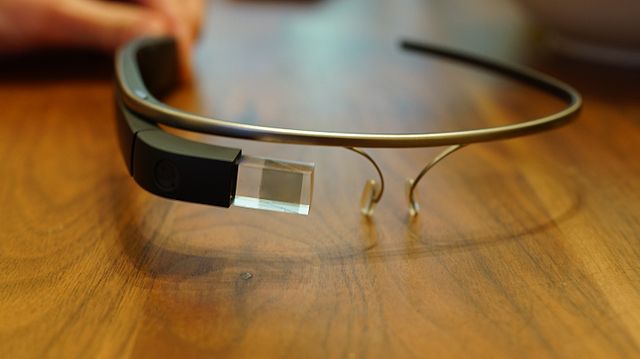By Juliana Nykolaiszyn
It was late in the day when a nondescript package arrived at my office. After carefully opening the box and lifting off the lid, there it was: Google Glass. And yes, it was awesome. Initially, the technology geek in me was overjoyed, but the oral historian soon took over as I raced through potential uses for this wearable technology in my daily work.

Google’s augmented reality head mounted display as glass form. Photo by Ted Eytan. CC BY-SA 2.0 via taedc Flickr.
I have found Google Glass provides unique challenges to and opportunities for conducting oral history, from interviewing to access. Worn like a pair of glasses, Google Glass allows users to take a photo, record video, get directions, send messages, search the Internet, make phone calls, and more with a simple voice command, “Ok Glass.” Google made this innovative piece of tech available to a limited audience of beta testers or “Glass Explorers” in 2013. Google Glass is easier to obtain today, cost remaining the most prohibitive factor. A lower cost consumer model is in the works, and is expected to be released later in 2014. This may dispel the social stigma that has developed around the wearable technology.
Over the last few months, I have put Google Glass through its paces with oral history in mind. I’ve learned that in an interview setting, Glass can be awkward for the narrator and the interviewer, and thus negatively impact the overall exchange. In fact, I was downright distracted while attempting to record with the unit, even in brief stretches. Maybe it is because I am not accustomed to wearing glasses, but there were other factors at play as well. First, you cannot zoom in while recording video, which limits framing the shot. And though Google Glass captures video in 720p, the battery limits recording time to approximately 43 minutes. Similarly, there is only 12 GB of usable memory. Another major downfall of Google Glass is the built-in microphone. The mic can easily and clearly record the person wearing the unit, but struggles to pick up other voices, such as narrators stationed at a comfortable distance. Furthermore, the mic is not omnidirectional, lessening the overall quality of recordings.
Click here to view the embedded video.
Here is an example of conducting an interview with Google Glass.
Credit: Oklahoma Oral History Research Program
Despite the technical shortcomings, I still see promise for using this type of wearable technology to gather oral histories. Google Glass can be used in instruction training tool. It provides a unique perspective for analysis, helping interviewers understand their connection to narrators, and to monitor head movements or gaze during a recording session. Another potential area of growth is access. Exhibits utilizing Google Glass are starting to emerge in several cultural institutions, including the New Museum in New York and the UK’s Manchester Art Gallery. Third-party applications are also being developed, which will only add to one’s ability to use Glass to enhance public displays. Finally, Glass may provide oral historians the ability to share interviews across geographic boundaries. Interviews can be live streamed via Google Hangouts, allowing for real-time access and interaction, perfect for connecting groups inside or outside the classroom.
At the end of the day, oral history is complimented by technology. While we have seen shifts and changes through the years, technology is still very important to recording, preserving, and accessing oral history. Google Glass may not be as robust as it could be for the purposes of documenting and preserving the history around us, but I am betting this type of wearable technology will move past these shortcomings sooner rather than later. As for its role in oral history, my initial experience suggests only time will tell how we will use it.
Juliana Nykolaiszyn is an Associate Professor/Librarian with the Oklahoma Oral History Research Program at the Oklahoma State University Library. She serves as an interviewer on several oral history projects, including the Inductees of the Oklahoma Women’s Hall of Fame, Oklahoma Centennial Farm Families, O-STATE Stories and the Spotlighting Oklahoma series. In addition to interviewing, Juliana is involved in making materials available online, primarily through CONTENTdm and other web-based efforts.
The Oral History Review, published by the Oral History Association, is the U.S. journal of record for the theory and practice of oral history. Its primary mission is to explore the nature and significance of oral history and advance understanding of the field among scholars, educators, practitioners, and the general public. Follow them on Twitter at @oralhistreview, like them on Facebook, add them to your circles on Google Plus, follow them on Tumblr, listen to them on Soundcloud, or follow their latest OUPblog posts via email or RSS to preview, learn, connect, discover, and study oral history.
Subscribe to the OUPblog via email or RSS.
Subscribe to only history articles on the OUPblog via email or RSS.
The post Oral history through Google Glass appeared first on OUPblog.


